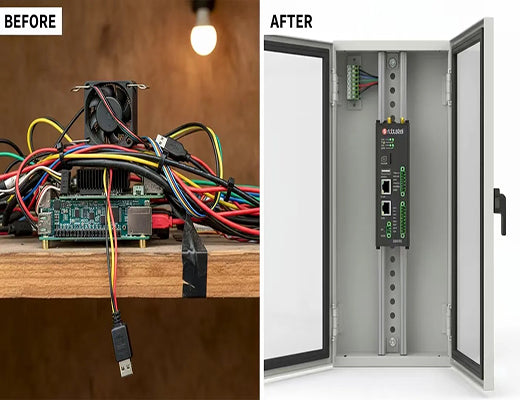
Using the EG5120 Industrial Edge Gateway for Home Automation with Home Assistant
|
|
Time to read 5 min
|
|
Time to read 5 min
For those serious about home automation, treating your smart home's core as a long-term investment is crucial.
This article reframes the conversation away from hobbyist gadgets and towards professional-grade infrastructure.
We explore why an industrial edge gateway for home automation is the ultimate foundation for a "forever" smart home. Discover how the Robustel EG5120, a device built for mission-critical applications, delivers the permanence, power, and future-proof flexibility that your Home Assistant setup truly deserves.
The allure of a cheap single-board computer is strong, I get it. It's how most of us got started with the brilliant, open-source world of Home Assistant. But as our systems grow from controlling a few lights to managing the entire home's security, climate, and energy, the stakes get higher. The conversation needs to shift from "what's the cheapest way to get started?" to "what's the most reliable way to build for the future?"
This shift in perspective leads you away from the consumer electronics aisle and into the world of professional hardware. It leads you to a class of device specifically designed for zero-failure scenarios: the industrial edge gateway for home automation.
Let's be clear: the Robustel EG5120 is not a typical consumer gadget. It was forged for environments where downtime is not an option—think smart factories, city-wide sensor networks, and remote energy grids. But the very reasons it excels in those harsh environments are what make it the perfect, unkillable core for a serious smart home.
This device is a compact powerhouse. It has a quad-core ARM processor, 2 GB of RAM, and crucially, 16 GB of rock-solid eMMC internal storage. It runs RobustOS Pro, an operating system based on the industry-standard Debian 11, which gives it an open and incredibly stable software environment. And the masterstroke? It fully supports Docker, allowing you to run Home Assistant and other services in secure, isolated containers.

Using an industrial edge gateway for home automation isn't about overkill; it's about adopting a professional mindset. It’s about building a system that you, your family, and future homeowners can depend on.

Choosing your home automation hardware is a strategic decision. You can opt for a low-cost entry point that you'll likely outgrow or have to replace after a failure, or you can invest in the digital foundation of your home.
Adopting an industrial edge gateway for home automation is that investment. It's the choice to prioritize permanence over price, and resilience over disposability. You've poured your passion into creating a smarter home; it's time to give that creation a foundation as solid and enduring as the home itself. To learn more about the software that powers this flexibility, explore the features of RobustOS Pro.

A1: It's not about being overkill; it's about matching the hardware to your ambition. If you view your smart home as a permanent, critical feature of your property—something that should add to its value and reliability—then using professional-grade hardware like the EG5120 is an excellent long-term investment.
A2: Yes, and that is a core part of its value. Thanks to its powerful processor and support for Docker on a Debian OS, it is an incredibly flexible platform. You can easily add new services and integrations over time without needing to buy new hardware. It’s designed to be the one and only hub you’ll need for the foreseeable future.
A3: It requires some basic familiarity with Linux and Docker, which represents a slight learning curve compared to a plug-and-play box. However, the vast majority of Home Assistant power users are already comfortable in this type of environment. The trade-off is a massive gain in long-term stability, security, and flexibility.